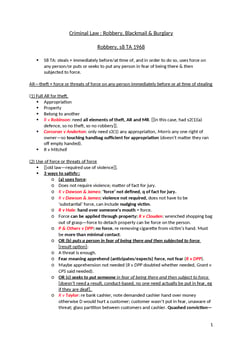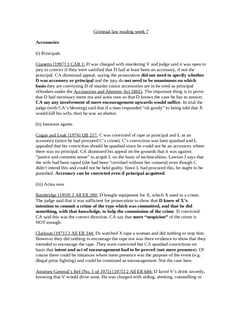R v Dawson [1985] 81 CAR 150
Judgement for the case R v Dawson
Table Of Contents
KEY POINTS
Manslaughter is a legal term that refers to the unlawful killing of another person. It involves the commission of an illegal act that leads to the death of the victim. The concept of manslaughter hinges on the occurrence of an unlawful act that directly results in the death of an individual. This legal definition shows the connection between the criminal act and its fatal consequences.
Acts exposing the victim to harm play a role. When proven to be unlawful, these acts form the basis for legal charges. The exposure to harm may lead to unintended but fatal outcomes, giving rise to manslaughter charges.
Understanding the meaning of harm is fundamental in the context of manslaughter. In this case, harm encompasses the physical injuries or adverse effects inflicted upon the victim due to the unlawful act.
Manslaughter charges may also arise when an unlawful act is committed in such a way that it profoundly shocks the victim, causing them physical injury. The shocking nature of the act, leading to unexpected harm, becomes a key element in establishing the legal grounds for manslaughter.
FACTS
Two masked men, one armed with a pickaxe handle and the other with a replica gun, along with a third individual as a lookout, demanded money from a 60-year-old petrol filling station attendant during the night. Unbeknownst to the assailants, the petrol station attendant suffered from heart disease. Responding to the threat, the attendant pressed the alarm, prompting the three men to flee.
Shortly after the police arrived, the petrol station attendant collapsed and died from a heart attack.
Approximately 11 months later, the appellants confessed to being the three men involved in the attempted robbery. However, they claimed to have learned of the attendant's death only at a later date. The appellants faced charges, including manslaughter, in connection with the incident.
During the trial, medical experts opined that the attempted robbery was a contributing factor to the attendant's death. However, they could not definitively rule out the possibility of a heart attack occurring before the attempted robbery.
The jury received directions, including the notion that putting a person in such terror could constitute harm, encompassing emotional or physical disturbance detrimental to the individual. They were instructed to consider whether all reasonable people, with the knowledge of the facts presented, would realize that the unlawful act inevitably created the risk of some harm.
The appellants were convicted and subsequently appealed, asserting, among other grounds, that the jury had been misdirected during the trial.
JUDGEMENT
The court ruled that "emotional disturbance" did not adequately describe harm caused by shock from terror or fright. Any jury inference that emotional disturbance alone constituted harm was a misdirection.
For manslaughter, it clarified the second element required an unlawful act recognized by sober individuals as likely to cause physical harm. The jury's misdirection on the "sober and reasonable man" knowledge, limited to a robber, was noted.
Notably, the appellants were unaware of the victim's heart condition. The court deemed the manslaughter convictions unsafe, allowed the appeals, and quashed the convictions.
COMMENTARY
The appellants faced manslaughter charges after attempting to rob a petrol station attendant, who later died from a heart attack.
The court found the initial jury direction on harm - allowing emotional disturbance to constitute harm - misguided. It clarified that emotional disturbance alone did not adequately describe the injury caused by shock from terror. The court stated that the harm referred to was physical, asserting that the requisite harm was established if the unlawful act profoundly shocked the victim, causing physical injury.
The jury was also misdirected on the knowledge of the "sober and reasonable man," limited to a person attempting robbery. With no indication that the appellants knew of the victim's heart condition, the court deemed the manslaughter convictions unsafe and unsatisfactory. The appeals were allowed, and the convictions were quashed, determining the need for a precise understanding of harm in manslaughter cases.
ORIGINAL ANALYSIS
3 men attempted to rob a petrol station but the alarm was pressed and thy fled. The attendant, who suffered from a weak heart, died of a heart attack after the attempted robbery.
It could only be established that there was a “high probability” that the attack set off the heart attack (it may have happened anyway).
They were convicted, the judge directing that frightening someone into physical or motional disturbance constituted harm, and when considering whether all reasonable people would recognise the danger of harm, this should be judged assuming the “reasonable man” knew the same facts as the jury. CA say the “reasonable man” should not be taken to have known that the attendant had a weak heart, and that an unlawful act would only be regarded as “dangerous” if it was likely to cause physical harm (not merely emotional shock).
-
Appeal against manslaughter was allowed since the judge misdirected the jury on what facts they could and could not use to decide whether or not the reasonable man would have seen the danger.
Surely this is wrong: Any reasonable person knows the potential to cause fear through pointing a gun (albeit replica) at someone and the possibility of causing physical harm through fear.
Therefore the action WAS dangerous and WAS unlawful and DID cause death. Therefore the appeal should have been dismissed.
Also the CA say that the robbers did not know the attendant had a weak heart: what about “take your victim as you find him?”- Blaue (though the judge in Blaue only applied this to cases of violence, whereas this was merely threatened violence). If I threaten someone with such extreme physical violence that they faint, am I not responsible for them fainting?
RELATED CASES
For Further Study on R v Dawson

A collection of the best GDL notes the director of Oxbridge Notes (an O...
Need instant answers? Our AI exam tutor is here to help.
Ask questions 🙋 Get answers 📔 It's simple 👁️👄👁️
Our AI is educated by the highest scoring students across all subjects and schools. Join hundreds of your peers today.
Get StartedRelated Product Samples
These product samples contain the same concepts we cover in this case.
| Criminal Law | Homicide Notes (20 pages) |
| GDL Criminal Law | Homicide 2 Involuntary Manslaughter Notes (11 pages) |
| Criminal Law | Murder Short Notes (12 pages) |

 Since 2010, Oxbridge Notes has been a trusted education marketplace, supplying high-quality materials from top achievers at universities like Oxford, Cambridge, LSE, Harvard, and Yale.
Since 2010, Oxbridge Notes has been a trusted education marketplace, supplying high-quality materials from top achievers at universities like Oxford, Cambridge, LSE, Harvard, and Yale.